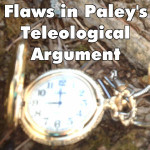Last night, while going to sleep, I was listening to a podcast of a show called Unbelievable?, which normally has a Christian debating an atheist. This episode was Is our universe more likely on atheism or theism? Calum Miller vs James Croft.
The Christian apologist Calum Miller argued that scientific laws make more sense under the assumption that God exists. The humanist James Croft argued that scientific laws are not as real a thing as Miller would make them out to be. He claimed that scientists make models of the world instead of discovering laws, and he claimed that the universe is more chaotic than our scientific laws would lead us to think. While there were some interesting ideas in Croft’s response, I think it was completely off the mark, and I will not try to defend it. I am not going to quibble over the existence of scientific laws, as if God really is required for such things to exist. Instead, my response is to explain why there are scientific laws, and why God is not required for their existence. The following video is based on this article, which continue below.
First, let’s clarify what scientific laws are. Scientific laws are descriptive, not prescriptive. Legislatures pass prescriptive laws. These tell people how to behave and impose penalties for not obeying the law. For example, we have laws against murder. These laws help ensure that we can normally go about our daily business without being murdered, but they do not prevent people from committing murder. Game rules are also prescriptive laws. It is against the rules of Chess to move a Knight in a straight line, but it is not physically impossible. Scientific laws are not at all the same thing as prescriptive laws. They are not legislated, and no one enforces them.
A scientific law describes regularities in nature. What we normally identify as scientific laws may be imperfect models of how the universe actually works. This is a good point that Croft makes. But this reflects the imperfect nature of scientific progress, not the realities behind our scientific laws. For example, Newton’s theory of gravity did not perfectly describe how gravity works, and Einstein’s theory of relativity described it better, and we still don’t fully know how gravity works on a quantum level. This is true, and Croft uses this very example. But it is also beside the point.
The scientific laws that scientists come up with are attempts to model the regularities that actually exist in nature. Whether or not we can model them perfectly, regularities in nature are real, and they can be explained without resorting to the idea that God must be behind them. Let’s begin with the observation that there are many different things in the universe. These things are made up of different arrangements of molecules. The same types of molecules can make up very different things. For example, H2O molecules may be part of an ocean, a cloud, a glacier, a snowball, various plants and animals, various beverages, or various other things. While there are numerous things in the universe, the types of molecules making them up are less numerous. Likewise, molecules are made up of atoms. I’m not sure how many types of molecules there are, but it is well over how many different types of atoms there are. The periodic table goes up to 118, and only 90 have been found in nature. Atoms are made up of three main components. These are protons, neutrons, and electrons. Finally, perhaps, these are made up of quarks.
What we see here is a general trend toward fewer and fewer types of things. While there are many types of molecules, there are fewer types of atoms, even fewer types of subatomic particles, and finally one type of thing. Miller put forth the idea that without God, the universe could very well be chaotic. Well, what would chaos look like? In a chaotic universe, we could expect many different kinds of things that have different properties and behave differently from each other. But if the universe is ultimately made up of one kind of thing, whatever properties this one kind of thing has will become a constituent part of everything that exists, generating regularities throughout nature. Let’s call this one type of stuff matter.
Protons, neutrons, and electrons are all made of matter. Atoms are made of these. Molecules are made of atoms, and all larger scale things are made of different arrangements of molecules. Let’s suppose that the universe has had stuff other than matter in it. We know anti-matter is a real thing, and when matter and anti-matter come together, they annihilate each other. If at some point, the universe was scattered with matter and anti-matter, the matter and anti-matter found together would annihilate each other, leaving only clean pockets of matter or anti-matter sufficiently far apart to not affect each other. Thus, we may live in part of the universe made up of matter, while other far-away parts of the universe are made up of anti-matter.
Hypothetically, there could be things other than matter and anti-matter. But I don’t know of such things, and the more unlike types of things we hypothesize, the greater the chance that some kind of deity would have to be behind their existence. In a universe without an intelligent creative force behind it, it makes more sense that everything would be made up of only one or two types of things.
Given that everything around us is matter, how does this result in real regularities? Let’s recall an axiom I’ve mentioned before. Other things being equal, more stable things remain around longer than less stable things. Let’s suppose we just have raw matter at the beginning of the universe. This matter will fall into various arrangements, some of which will be more stable than others. Protons, neutrons, and electrons are stable arrangements of matter. We have these throughout the material universe, because matter that falls into these arrangements remains in them for a very long time. Whether here or in another galaxy, these subatomic particles have the same properties. This results in regularities throughout the universe.
Let’s now turn to atoms. The most abundant atom is hydrogen, with an atomic number of 1. With free electrons, protons and neutrons sailing around, this is the most natural arrangement for them to fall into, and it is a very stable one. It is so stable that it takes the power of a star to fuse hydrogen atoms together to create atoms with higher atomic numbers. The original stars formed through the gravitational attraction of hydrogen atoms to each other, eventually becoming massive enough to fuse hydrogen atoms into helium and other atoms. As it takes more work to fuse atoms into ones with higher atomic numbers, we can generally expect elements with lower atomic numbers to be more plentiful than elements with higher atomic numbers, though other factors may work against some atomic numbers. For example, Lithium (3), Beryllium (4), and Boron (5) are much less common than several elements with higher atomic numbers, because they don’t form as easily. Only elements with atomic numbers up to 26, which is iron, get formed in stars. Heavier elements get formed in supernovas. And only 90 of the 118 known elements are known to form in nature at all. And many of the elements formed only in the laboratory are unstable and don’t last. So, the greater difficulty in forming heavier elements, and the greater instability of heavier elements, has the effect of limiting the elements available in nature to 90 with a greater abundance of the lighter elements. This regularity should be found throughout the universe, and it just follows from the nature of things, not from design.
We should naturally expect the same elements to have the same properties in different parts of the universe. It’s true that different conditions may prevail in different parts of the universe. The same element could be gaseous, liquid, or solid depending upon its environment. But this is not a difference in the properties of the element. To spell out the properties of an element, we should say it is gaseous under these conditions, liquid under these, solid under those, etc. Since the same elements have the same properties wherever they are found in the universe, we may expect regularities to show up wherever the same elements are found. This includes the formation of the same types of molecules and the same properties for the same types of molecules. Since the abundance of different elements is a non-random matter depending on the ease of forming an element and its subsequent stability, we should also expect similar proportions of the elements around the universe. This just adds to the regularities there are to be found.
So, thanks to things ultimately being made up of one simple kind of stuff, what we may call matter, there are numerous regularities that are just part of the nature of things. These have not been designed or legislated by anyone. They just arise from the nature of matter. So the expectation scientists have of being able to understand the universe through scientific laws is not misguided, and it does not require the existence of a creator.



